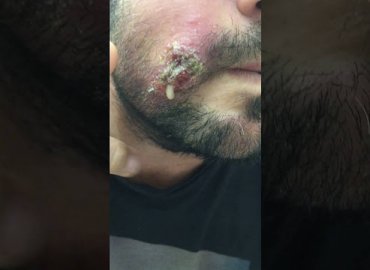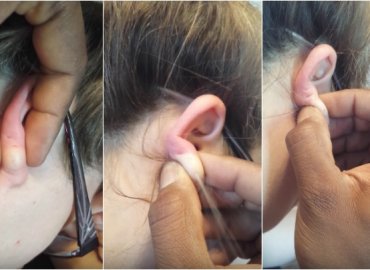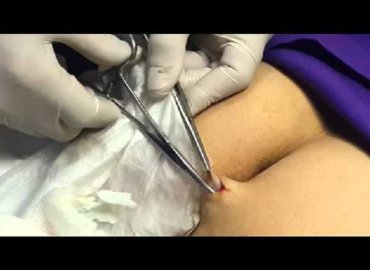An epidermoid cyst (Epidermal Inclusion cyst, Infundibular cyst), is a benign growth commonly found in the skin and typically appears on the face, neck or trunk, but can occur anywhere on the body.
Another name used is “sebacous cyst” but this is actually an antiquated misnomer, and is not a term used by dermatologists. They are also the most common type of cutaneous cysts.
Epidermoid cysts result from the reproduction of epidermal cells within a confined space of the dermis. The pasty contents are mostly composed of macerated keratin (wet skin cells), which creates this “cheesy” consistency, and there can be a pungent odor. An epidermoid cyst may have no symptoms and are typically harmless.
Usually people seek removal because they don’t like the appearance of these bumps, or the cyst has ruptured or been inflamed or “infected” in the past. Rupture is associated with sudden redness, pain, swelling, and local heat, and can lead to abscess formation. Also, a history of inflammation, often increases scar tissue in the area, makes the cyst more firmly adherent to surrounding skin, and makes it more difficult to remove.
Surgical excision is curative, but the complete cyst removal including the entire cyst sac and contents need to be removed to ensure that the cyst won’t reoccur.
Distinguish between cysts in the breast and tumors. Cysts can be in one or both breasts. Without a mammogram or needle biopsy it is almost impossible to distinguish between the two different types of lumps in the breast. Symptoms of a breast cyst will include:
- Smooth, easily movable lump with distinct edges
- Pain or tenderness over the lump
- Size and tenderness will increase just before your period starts
- Size and tenderness will decrease when your period ends
Understand cystic acne. Acne is a general term that describes a variety of different types of pimples, blackheads, pustules, whiteheads and cysts. Cystic acne are nodules that are red, raised, often 2–4 mm in size and nodular and are the most severe form of acne. The infection in a cystic acne is deeper than that in other pustules or whiteheads. Cystic acne is painful.
Identify a ganglion cyst. These are the most common types of lumps found on the hand and wrist. They are not cancerous and often harmless. Filled with fluid, they can quickly appear, disappear or change in size. They do not require treatment unless they interfere with function or are unacceptable in appearance.
Treating a Cyst at Home
Treat uninfected epidermoid and sebaceous cysts at home. Signs of infection include the area becoming swollen, red, tender, or red and warm. If your home treatment for these cysts is not effective or if you experience symptoms, which indicate an infection, you should seek medical care from your physician.
If the cyst causes pain or discomfort with walking or intercourse, medical care is needed to treat the cyst.
Use a wet, warm compress over an epidermoid cyst to encourage it to drain and heal. The washcloth should be hot but not so hot that it burns the skin. Place it over the cyst two to three times a day.
Cystic acne responds better to ice than it does to heat.
Bartholin gland cysts can be treated at home using warm water sitz baths. This involves sitting in several inches of warm water to encourage the cyst to drain.
Refrain from picking, squeezing, or trying to pop either an epidermoid cyst or sebaceous cyst. This can increase the risk of infection and scarring. Also, never pick, squeeze or attempt to pop a cystic acne. This drives the infection deeper and increases the risk of scar tissue.
Allow an epidermoid cyst to drain naturally. Once it begins to drain, cover it with a sterile dressing, which you can change twice a day. If a large amount of pus begins to drain from the cyst, the skin surrounding the cyst turns red, the area becomes warm and tender, or blood begins to drain from the cyst, it is time to seek medical care.
Keep the area clean. To prevent an infection, keep the cyst and the area surrounding it clean. Wash it daily using an antibacterial soap or cream.







